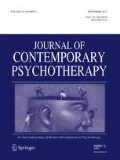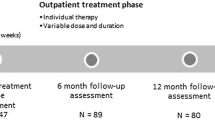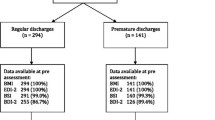Abstract
The present study was designed to evaluate the outcomes of a day treatment program for 55 eating disordered (ED) patients using clinical and statistical significance testing. Results indicated a statistically significant reduction on all eating disordered outcomes. With respect to clinical significance testing, analysis of these data indicated that the majority of the individuals in the day treatment program made clinically significant and reliable change by the termination of treatment on all eating disorder measures. However, considerably less patients improved to such a point that they were asymptomatic. The importance of combining clinical significance testing with traditional significance testing is discussed.
Similar content being viewed by others
Notes
RCI Computational Formula for Individual Data (Jacobson and Truax 1991); \( {\text{RCI}} = x_{\text{pre}} - x_{\text{post}} /S_{\text{diff}} \) , \( S_{\text{diff}} = \left( {2({\text{SE}})^{2} } \right)^{ \, 1/2} ;\quad \quad {\text{SE = SD}}_{\text{pre}} (1 - r_{\text{ xx}} )^{1/2} . \)
References
Abramowitz, J. S. (1998). Does cognitive-behavioral therapy cure obsessive-compulsive disorder? A meta-analytic evaluation of clinical significance. Behavior Therapy, 29(2), 339–355.
American Psychiatric Association Work Group on Eating Disorders. (2000). Practice guideline for the treatment of patients with eating disorders. American Journal of Psychiatry, 157, 1–39.
Beck, A. T., Steer, R. A., & Brown, G. K. (1996). Manual for Beck depression inventory-II. San-Antonio, TX: Psychological Corporation.
Becker-Stoll, F., & Gerlinghoff, M. (2004). The impact of a four-month day treatment program on alexithymia in eating disorders. European Eating Disorders Review, 12(3), 159–163.
Fairburn, C. G., & Beglin, S. J. (1994). The assessment of eating disorders: Interview or self-report questionnaire? International Journal of Eating Disorders, 16, 363–370.
Garner, D. M. (1991). The eating disorder inventory-II. Professional manual. Odesa (FA): Psychological Assessment Resources.
Garner, D. M., Olmsted, M. P., Polivy, J., & Garfinkel, P. E. (1984). Comparison between weight-preoccupied women and anorexia nervosa. Psychosomatic Medicine, 46(3), 255–266.
Gerlinghoff, M., Backmund, H., & Franzen, U. (1998). Evaluation of a day treatment programme for eating disorders. European Eating Disorders Review, 6, 96–106.
Jacobson, N. S., & Truax, P. (1991). Clinical significance: A statistical approach to defining meaningful change in psychotherapy research. Journal of Consulting and Clinical Psychology, 59, 12–19.
Kachele, H., Kordy, H., & Richard, M. (2001). Therapy amount and outcome of inpatient psychodynamic treatment of eating disorders in Germany: Data from a multicenter study. Psychotherapy Research, 11(3), 239–257.
Kahn, C., & Pike, K. M. (2001). In search of predictors of dropout from inpatient treatment for anorexia nervosa. International Journal of Eating Disorders, 30(3), 237–244.
Kaplan, A. S., & Olmsted, M. P. (1997). Partial hospitalization. In D. M. Garner & P. E. Garfinkel (Eds.), Handbook of treatment for eating disorders.
Kendall, P. C. (Ed.) (1999). Clinical significance [Special Section]. Journal of Consulting and Clinical Psychology, 67, 283–339.
Kong, S. (2005). Day treatment programme for patients with eating disorders: Randomized controlled trial. Journal of Advanced Nursing, 51, 5–14.
LaGreca, A. M. (2005). Editorial. Journal of Consulting and Clinical Psychology, 73, 3–5.
Luce, K. H., & Crowther, J. H. (1999). The reliability of the Eating Disorder Examination—Self-Report Questionnaire Version (EDE-Q). International Journal of Eating Disorders, 25(3), 349–351.
Lundgren, J. D., Danoff-Burg, S., & Anderson, D. A. (2004). Cognitive-behavioral therapy for bulimia nervosa: An empirical analysis of clinical significance. International Journal of Eating Disorders, 35, 262–274.
Manara, F., Manara, A., & Todisco, P. (2005). Correlation between psychometric and biological parameters in anorexic and bulimic patients during and after and intensive day hospital treatment. Eating and Weight Disorders, 10(4), 236–244.
Mehran, F., Leonard, T., & Samuel-Lajeunesse, B. (1999). Anorexia nervosa: Changes in the perception of femininity, figure, diet, and clothing concepts with inpatient treatment. European Eating Disorders Review, 7(2), 111–120.
Ogrodniczuk, J. S., & Steinberg, P. (2005). A renewed interest in day treatment. Canadian Journal of Psychiatry, 50(1), 77.
Olmstead, M. P., Kaplan, A. S., & Rockert, W. (2003). Relative efficacy of a 4-day versus a 5-day hospital program. International Journal of Eating Disorders, 34, 441–449.
Piran, N., Langdon, L., Kaplan, A., & Garfinkel, P. E. (1989). Evaluation of a day hospital program for eating disorders. International Journal of Eating Disorders, 8, 511–521.
Solenberger, S. E. (2001). Exercise and eating disorders: A 3-year inpatient hospital record analysis. Eating Behaviors, 2(2), 151–168.
Thornton, C., Beumont, P., & Touyz, S. (2002). The Australian experience of day programs for patients with eating disorders. International Journal of Eating Disorders, 25, 227–231.
Wisniewski, L., & Ben-Porath, D. (2005). Telephone coaching with eating disordered clients: Clinical Guidelines using the DBT Model. European Eating Disorders Review, 13, 344–350.
Wisniewski, L., & Kelly, E. (2003). Can DBT be used to effectively treat eating disorders? Cognitive and Behavioral Practice, 10, 131–138.
Zeeck, A., Herzog, T., & Hartmann, A. (2004). Day clinic or inpatient care for severe bulimia nervosa? European Eating Disorders Review, 12, 79–86.
Zipfel, S., Reas, D. L., Thornton, C., Olmsted, M. P., Williamson, D. A., Gerlinghoff, M., et al. (2002). Day hospitalization programs for eating disorders: A systematic review of the literature. International Journal of Eating Disorders, 31, 105–117.
Acknowledgment
We would like to thank the clients and their therapists for participation in this study.
Author information
Authors and Affiliations
Corresponding author
Rights and permissions
About this article
Cite this article
Ben-Porath, D.D., Wisniewski, L. & Warren, M. Outcomes of a Day Treatment Program for Eating Disorders Using Clinical and Statistical Significance. J Contemp Psychother 40, 115–123 (2010). https://doi.org/10.1007/s10879-009-9125-5
Published:
Issue Date:
DOI: https://doi.org/10.1007/s10879-009-9125-5




